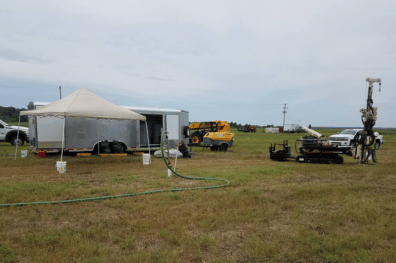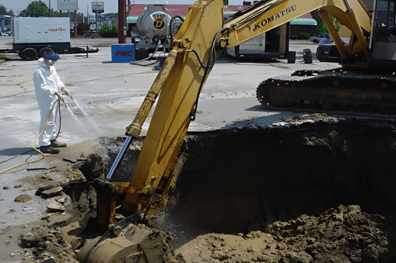ORIN successfully conducted a pilot test to treat groundwater contaminated with GRO, DRO, Crude Oil, and PVOC utilizing BAM, a pyrolized cellulosic material, VB591 nutrient blend. Two pilot areas were conducted: one with BAM alone (IW-3) and one with BAM mixed with nutrients (IW-2). DPT points were advanced around each well.
The treatment chemistry was mixed with water and injected through DPT points utilizing a side injection rod. A total of 2,740 gallons of solution was injected between the two areas. During injection activities, a vacuum truck extracted groundwater from various wells within and adjacent to the injection areas.
The Challenge
The site presented complex contamination:
- Multiple contaminant types:
- Gasoline Range Organics (GRO)
- Diesel Range Organics (DRO)
- Crude Oil
- Petroleum Volatile Organic Compounds (PVOC)
- Need for treatment verification
- Multiple treatment approach testing
- Distribution effectiveness requirements
The Solution: Comparative Pilot Study
The team implemented two distinct treatment approaches:
- BAM-Only Area (IW-3):
- BAM technology alone
- Strategic DPT points
- Side injection rod methodology
- Distribution verification
- Enhanced Treatment Area (IW-2):
- BAM technology
- VB591 nutrient blend integration
- Identical injection methodology
- Performance comparison
Implementation Details
Key operational elements:
- 2,740 gallons total solution
- Strategic DPT placement
- Vacuum truck extraction support
- Adjacent well monitoring
- Distribution optimization
Outstanding Results
Both approaches achieved complete success:
- 100% reduction in all contaminants
- Non-detect levels achieved
- Consistent results across three sampling rounds
- Successful treatment distribution
- Validated methodology
Key Success Factors
Several elements contributed to perfect results:
- Dual treatment comparison
- Strategic vacuum extraction
- Comprehensive monitoring
- Optimal chemistry combinations
- Distribution verification
Innovation Highlights
The project demonstrated several advantages:
- Complete contaminant elimination
- Multiple treatment validation
- Successful methodology testing
- Effective distribution strategy
- Scalable approach
Path to Full Implementation
Success factors leading to full-scale approval:
- Consistent non-detect results
- Validated treatment approaches
- Proven distribution methods
- Multiple round verification
- Clear implementation pathway
This case study demonstrates how well-designed pilot studies can provide perfect results and clear direction for full-scale implementation.



